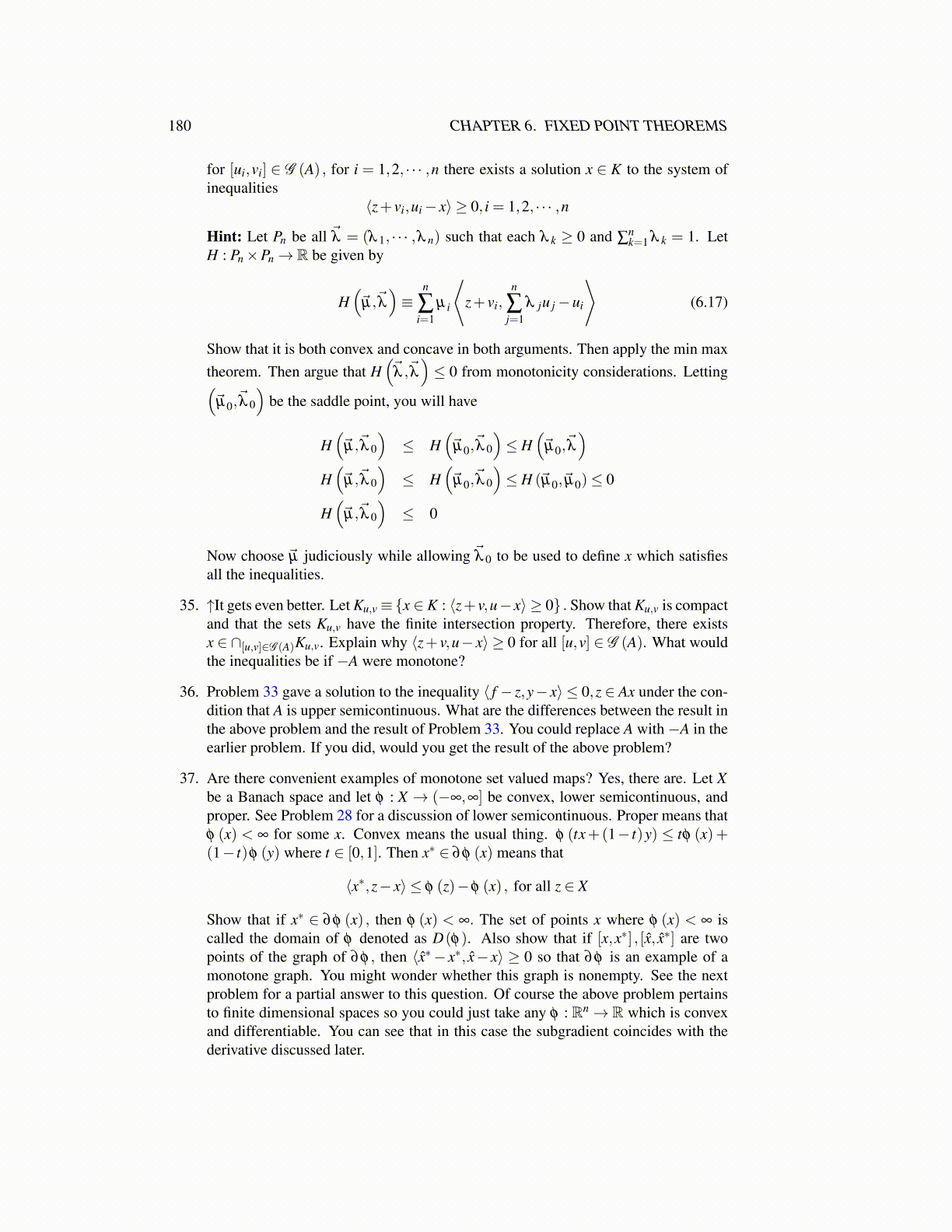
180 CHAPTER 6. FIXED POINT THEOREMS
for [ui,vi] ∈ G (A) , for i = 1,2, · · · ,n there exists a solution x ∈ K to the system ofinequalities
⟨z+ vi,ui− x⟩ ≥ 0, i = 1,2, · · · ,n
Hint: Let Pn be all λ⃗ = (λ 1, · · · ,λ n) such that each λ k ≥ 0 and ∑nk=1 λ k = 1. Let
H : Pn×Pn→ R be given by
H(
µ⃗, λ⃗)≡
n
∑i=1
µ i
⟨z+ vi,
n
∑j=1
λ ju j−ui
⟩(6.17)
Show that it is both convex and concave in both arguments. Then apply the min maxtheorem. Then argue that H
(⃗λ , λ⃗
)≤ 0 from monotonicity considerations. Letting(
µ⃗0, λ⃗ 0
)be the saddle point, you will have
H(
µ⃗, λ⃗ 0
)≤ H
(µ⃗0, λ⃗ 0
)≤ H
(µ⃗0, λ⃗
)H(
µ⃗, λ⃗ 0
)≤ H
(µ⃗0, λ⃗ 0
)≤ H (⃗µ0, µ⃗0)≤ 0
H(
µ⃗, λ⃗ 0
)≤ 0
Now choose µ⃗ judiciously while allowing λ⃗ 0 to be used to define x which satisfiesall the inequalities.
35. ↑It gets even better. Let Ku,v≡{x ∈ K : ⟨z+ v,u− x⟩ ≥ 0} . Show that Ku,v is compactand that the sets Ku,v have the finite intersection property. Therefore, there existsx ∈ ∩[u,v]∈G (A)Ku,v. Explain why ⟨z+ v,u− x⟩ ≥ 0 for all [u,v] ∈ G (A). What wouldthe inequalities be if −A were monotone?
36. Problem 33 gave a solution to the inequality ⟨ f − z,y− x⟩ ≤ 0,z ∈ Ax under the con-dition that A is upper semicontinuous. What are the differences between the result inthe above problem and the result of Problem 33. You could replace A with −A in theearlier problem. If you did, would you get the result of the above problem?
37. Are there convenient examples of monotone set valued maps? Yes, there are. Let Xbe a Banach space and let φ : X → (−∞,∞] be convex, lower semicontinuous, andproper. See Problem 28 for a discussion of lower semicontinuous. Proper means thatφ (x) < ∞ for some x. Convex means the usual thing. φ (tx+(1− t)y) ≤ tφ (x)+(1− t)φ (y) where t ∈ [0,1]. Then x∗ ∈ ∂φ (x) means that
⟨x∗,z− x⟩ ≤ φ (z)−φ (x) , for all z ∈ X
Show that if x∗ ∈ ∂φ (x) , then φ (x) < ∞. The set of points x where φ (x) < ∞ iscalled the domain of φ denoted as D(φ). Also show that if [x,x∗] , [x̂, x̂∗] are twopoints of the graph of ∂φ , then ⟨x̂∗− x∗, x̂− x⟩ ≥ 0 so that ∂φ is an example of amonotone graph. You might wonder whether this graph is nonempty. See the nextproblem for a partial answer to this question. Of course the above problem pertainsto finite dimensional spaces so you could just take any φ : Rn→ R which is convexand differentiable. You can see that in this case the subgradient coincides with thederivative discussed later.